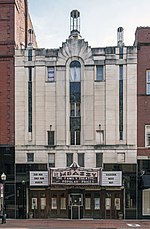B'er Chayim Temple
1866 establishments in MarylandAshkenazi synagoguesBuildings and structures in Cumberland, MarylandDowntown Cumberland, MarylandGerman-Jewish culture in Maryland ... and 12 more
Greek Revival architecture in MarylandGreek Revival synagoguesJews and Judaism in AppalachiaNational Register of Historic Places in Allegany County, MarylandPages with login required references or sourcesReligion in Cumberland, MD-WV-PAReligious buildings and structures in Allegany County, MarylandReligious organizations established in 1853Synagogues completed in 1866Synagogues on the National Register of Historic Places in MarylandUse American English from June 2014Use mdy dates from June 2014

B'er Chayim Temple (Hebrew for Well of Life, a metaphor in which Torah is likened to water) is a synagogue in Cumberland, Maryland that is currently affiliated with the Reform movement. B'er Chayim counts approximately 72 families as members.B'er Chayim is the oldest synagogue building in continuous use as a synagogue in Maryland and the sixth oldest in the United States.
Excerpt from the Wikipedia article B'er Chayim Temple (License: CC BY-SA 3.0, Authors, Images).B'er Chayim Temple
South Centre Street, Cumberland
Geographical coordinates (GPS) Address Nearby Places Show on map
Geographical coordinates (GPS)
| Latitude | Longitude |
|---|---|
| N 39.650555555556 ° | E -78.760555555556 ° |
Address
South Centre Street 198
21502 Cumberland
Maryland, United States
Open on Google Maps










